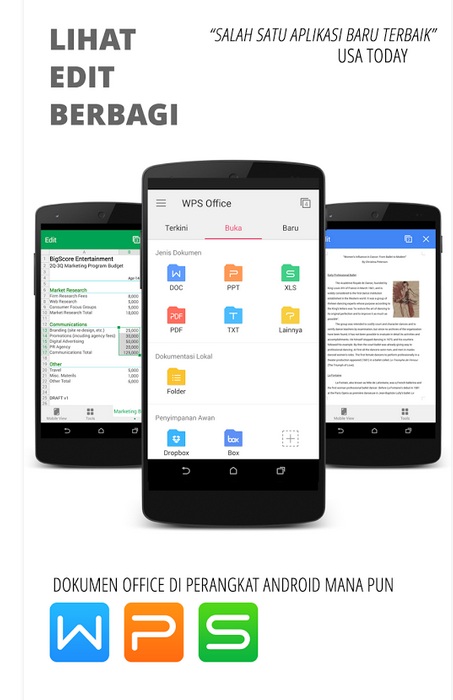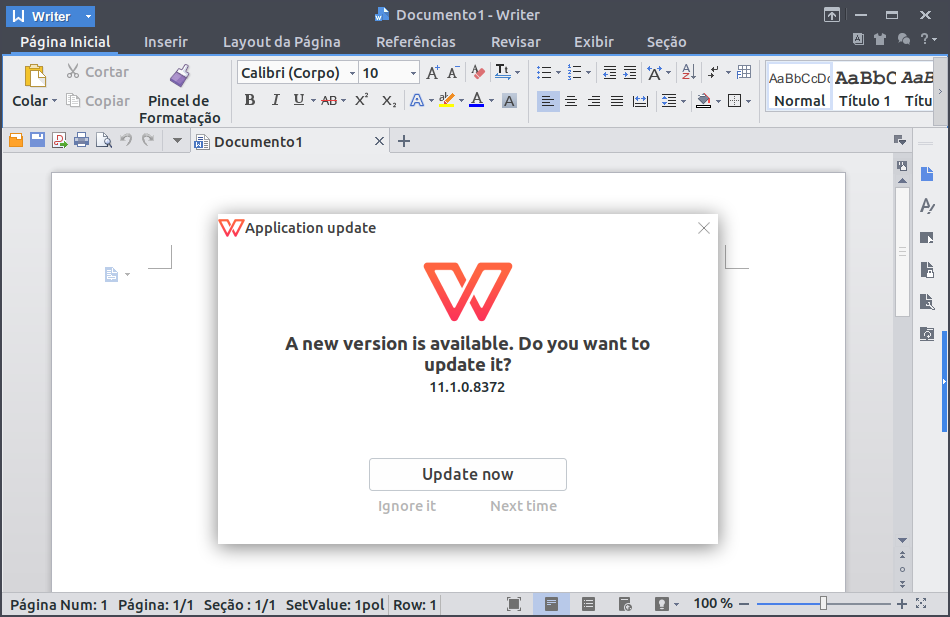has released guidance regarding the annual pesticide safety training requirements outlined in the Agricultural Worker Protection Standard (WPS) that offers flexibility during the COVID-19 public health emergency. Read it here.
WRF Preprocessing System Version 3: Updates. WPS Version 3.0.1 WPS Version 3. Version 3 of the WRF Pre-Processing System (WPS) was released on April 4, 2008. Note: The V3 WRF model is NOT backward compatible with old input files. One must rerun WPS to generate data for real/wrf. Also see 'Known Problems' in this release. WPS is an excellent free alternative to Office 365. The software includes a word processor, spreadsheet tool, presentation, and a PDF reader. The latest version is an all-in-one software that uses a tabbed interface when choosing between the Writer, Presentation, or Spreadsheet tools. WPS Office is compatible with Office 365.

Worker Protection Standard (WPS) Update May 8-9, 2019 Pesticide Program Dialogue Committee Meeting Summary:. The EPA issued a final rule in November 2015, establishing staggered compliance dates for implementation of the changes to the Agricultural Worker Protection Standard. Below are the current reporting trends for key indicators calculated from data reported to the Ohio Department of Health. These trends are updated daily and are presented by report date.
EPA's Agricultural Worker Protection Standard (WPS) aims to reduce pesticide poisonings and injuries among agricultural workers and pesticide handlers. The WPS offers occupational protections to over 2 million agricultural workers and pesticide handlers who work at over 600,000 agricultural establishments. EPA revised the WPS to decrease pesticide exposure incidents among farmworkers and their family members. Fewer incidents means a healthier workforce and fewer lost wages, medical bills and absences from work and school.
All requirements of the revised WPS are now in effect. Pesticide safety training materials with the expanded content required by the 2015 WPS must be used to train workers and handlers. EPA-approved training materials for national use are available on the Pesticide Educational Resources CollaborativeEXITwebsite.
On October 30, 2020, EPA finalized narrow updates to the Application Exclusion Zone (AEZ) provisions under the Worker Protection Standard regulation. To view the final rule, please visit docket EPA-HQ-OPP-2017-0543.

Groups Covered by the WPS
The WPS protects two types of employees on farms, forests, nurseries and greenhouses from occupational exposure to agricultural pesticides:
- Pesticide handlers — those who:
- mix, load or apply agricultural pesticides;
- clean or repair pesticide application equipment; or
- assist with the application of pesticides.
- Agricultural workers — those who perform tasks related to growing and harvesting plants on farms or in greenhouses, nurseries or forests.
- Workers include anyone employed for any type of compensation (including self-employed) doing tasks such as:
- carrying nursery stock;
- repotting plants;
- watering; or
- other tasks directly related to the production of agricultural plants on an agricultural establishment.*
- Workers include anyone employed for any type of compensation (including self-employed) doing tasks such as:
*Some requirements apply to anyone doing certain tasks, such as handling pesticide application equipment or cleaning or laundering pesticide-contaminated personal protective equipment.
Complying with the WPS
Turbulencefd for mac. This section provides an overview of who is required to comply with the WPS and a list of compliance requirements.
In general, employers are responsible for WPS compliance. These include:
- Owners/employers on agricultural establishments that grow and harvest for commercial production:
- Fruits and vegetables on farms.
- Timber and trees in forests and nurseries.
- Plants in greenhouses and nurseries.
- Employers of researchers who help grow and harvest plants.
- Employers at commercial pesticide handling establishments.

Under the WPS, all employers are required to do the following:
- Do not retaliate against a worker or handler.
- Provide annual pesticide safety training.
- Provide access to specific information for workers and handlers at a central location during normal work hours, including: (agricultural employers only).
- Pesticide applications on the establishment;
- Safety Data Sheets for pesticides applied on the establishment; and
- Pesticide safety information that includes emergency information.
- Provide WPS-required safety, pesticide application, and hazard information to workers and handlers or their designated representative, or to treating medical personnel, if requested. For additional details, see the Designated Representative section of this webpage or Chapter 2 of the WPS How to Comply Manual. See full requirements at 40 CFR 170.311(b).
- Provide decontamination supplies.
- Exchange information (between a commercial handler employer and an operator of an agricultural establishment).
- Provide emergency assistance by making transportation available to a medical care facility in case of a pesticide injury or poisoning and providing information about the pesticide(s) to which the person may have been exposed.
In addition to the duties listed above for all employers, employers of workers are required to do the following:

- Implement restrictions during applications by keeping workers and other people out of the treated field and application exclusion zones.
- Implement restricted-entry intervals (REIs).
- Implement protections for early entry by workers, including:
- Providing access to labeling information;
- Specific information on early entry tasks; and
- Required early entry Personal Protective Equipment.
- Notify workers about applications and pesticide-treated areas and not to enter during the REI by:
- providing oral warnings; or
- posting warning signs.
In addition to the duties listed above for all employers, employers of pesticide handlers are required to do the following:
- Implement restrictions during applications by ensuring that pesticides applied do not contact workers or other people. Also, handlers must suspend an application if workers or other people are in the application exclusion zone.
- Monitor handlers working with toxic pesticides.
- Provide specific instructions for handlers.
- Provide access to labeling information for handlers.
- Take steps to ensure equipment safety.
- Personal Protective Equipment (PPE):
- Provide required PPE in clean and good operating condition.
- Ensure PPE is worn correctly.
- Provide a clean place for storing personal clothing and removing PPE.
- Care for, maintain and replace damaged or worn PPE.
- Replace respirator purifying elements.
- Dispose of contaminated PPE.
- Provide instructions for people who clean PPE.
- Provide a medical evaluation, fit test and respirator training to handlers required to wear a respirator by the pesticide label.
Exceptions to the WPS

The following situations are exceptions from the requirements in the WPS:
Wps Updates 2020
- Owners and immediate family members on family-owned farms are exempt from many of the WPS requirements.
- Certified or licensed crop advisors who perform crop advisor tasks are exempt from certain WPS provisions including pesticide safety training.
- Limited and narrow circumstances: The WPS does not apply when pesticides are applied on an agricultural establishment in certain limited circumstances.
Designated Representative
The designated representative provision was added to the 2015 revision of the WPS. The following information provides additional explanation of this provision and examples to help groups covered by the WPS understand how to use of the designated representative provision correctly.
Per 40 CFR § 170.305 of the 2015 WPS regulation revision, a “designated representative” is any person(s) designated in writing by a worker or handler to exercise a right of access on his or her behalf to request and obtain a copy of the pesticide application and hazard information from a worker’s employer. The employer is required to make this information available to the employee or his/her designated representative under §170.311(b)(1) of this part.
Anyone can be a designated representative — for example, a coworker or a family member.
Examples of why a worker or handler may choose to utilize a designated representative include:
- If there is a language barrier;
- If the worker or handler has moved and cannot access the information themselves;
- If a case worker needs information for workers compensation review.
Under the regulations, a designated representative may request WPS-required pesticide application and hazard information for applications made while the worker or handler was employed on the establishment (going as far back as two years). This request, made to the worker’s employer, must be in writing.
Under the regulations, the written request must contain the following:
- The name of the worker or handler being represented;
- A description of the specific information being requested, including:
- Dates of employment of the worker or handler,
- The date(s) for which the records are requested,
- Type of work conducted by the worker or handler during the period for which the records are requested, and
- The specific application and hazard information requested;
- A written statement clearly designating the representative to obtain this information on the worker’s or handler’s behalf, with the worker’s or handler’s printed name and signature, the date of the designation, and the printed name and contact information for the designated representative; and
- Where the worker’s employer should send the information, if the information is to be sent.
As specified in 40 CFR 170.311(b)(1), designated representatives may access:
- A copy of the safety data sheet.
- The name, EPA registration number, and active ingredient(s) of the pesticide product.
- The crop or site treated and the location and description of the treated area.
- The date(s) and times the application started and ended.
- The duration of the applicable labeling-specified restricted-entry interval for that application.
Under the regulations, the employer must provide a copy or access to the requested information within 15 days of receiving the request. If the worker’s employer has previously provided the record without cost to the same worker or handler or their designated representative, a reasonable fee may be charged for duplicate records, but the fee may not include any discriminatory costs or overhead charges.
See page 7 of Chapter 2 of the How to Comply ManualExitfor additional information. See full requirements at 40 CFR 170.311(b).
All states enforce the federal WPS. Additionally, some states have implemented their own worker protection laws. Examples of designated representative requirements from states include:
- Florida Agricultural Worker Safety Act (FAWSA) includes a “designated representative” definition; summarized by University of Florida Institute of Food and Agricultural Sciences ExtensionExit
- California Department of Pesticide Regulation 3 CCR 6761. Hazard Communication for FieldworkersExit; summarized at Right to Obtain InformationExit
- Texas Agricultural Hazard Communication Law contains a provision for a “designated representative;” summarized at Texas Worker Protection LawExit
Learn more about the designated representative provision in Chapter 2 of EPA’s How to Comply Manual -- Requirements for Agricultural Employers Of Workers or Handlers. Exit
To get more information on or ask a question about the designated representative provision, email us at OPP_designated_rep_info@epa.gov.
More Information on the Overall WPS
Wps Office Free Download For Windows 10
Per 40 CFR § 170.305 of the 2015 WPS regulation revision, a “designated representative” is any person(s) designated in writing by a worker or handler to exercise a right of access on his or her behalf to request and obtain a copy of the pesticide application and hazard information from a worker’s employer. The employer is required to make this information available to the employee or his/her designated representative under §170.311(b)(1) of this part.
Kingsoft Office Free Windows 10
- Quick Reference Guide (PDF) (2 pp, 243 K, About PDF) Exit
- Guía de referencia rápida (en español)
- Cuadro comparativo de WPS vigente y norma revisada (en español)
